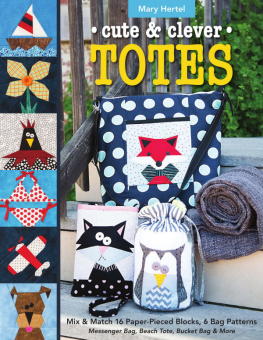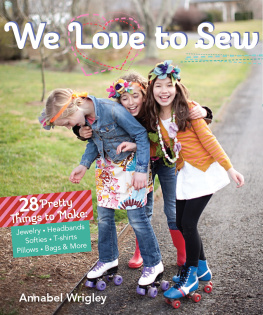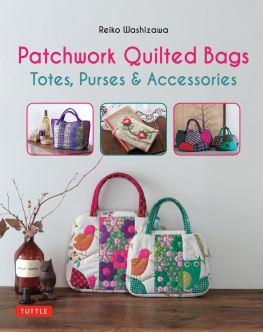INTRODUCTION
Having a collection of versatile bags is such an essential part of every womans wardrobe. We use bags in so many ways and for so many different functions. No matter how many bags we have, we always yearn for more! In this book, I have put together a collection of twelve distinct designs that expand into 20 projects for bags that will multitask quite nicely for just about anyone.
Each bag has its own individual style from sophisticated to cool and casual, while keeping function and ease of use at the core of each design. I want you to feel that what I have offered to you here is merely a stepping-stone to take each of these designs and make them your own. We all have a unique vision for what is the ultimate in a bag. My goal is for you to feel confident with adding or subtracting details to make each bag the ultimate for you or whomever you might be making the bag for.
I love to design and make bags! The challenge of making a bag to suit a certain need is what I find the most intriguing about the process. I usually start with pencil and paper and make a simple sketch of the design I have in mind. I then think about the finished dimensions of the bag and assign measurements to the different components of height, width and depth. Then comes the fun part: adding seam allowances, shaping the pieces and figuring out the best way to put the parts together that makes sound construction sense, as well as addressing the overall durability of the design. This is obviously the most time-consuming portion of the work and where prototypes come to life in my process. Throughout the book, you will see a sketch of where my design started and then the actual photographs of the finished project. In a lot of respects, the design will hold true to the original sketch, but sometimes a detail here or there will change based on what happens during the prototype phase. I like to let the design tell me where to go next. My hope is that by seeing into my process a bit, you can apply your own creativity here and there.
Indispensable Notions
MEASURING TOOLS
Dressmakers Measuring Tape: This tape is about 60 long and is very flexible. Its perfect for taking body measurements and other varied measuring uses when you need a flexible tool.
Quilting Ruler: I love my 24 6 quilting ruler! It is transparent so I can use it for a variety of measuring needs. I use it often for cutting strips of fabric with my mat and rotary cutter. Even if you dont quilt, this is a great tool.
MARKING TOOLS
Marking Pencils: There is a variety of tools out there, from chalk pencils to air-soluble markers. Ive recently discovered Sewline marking pencils. What can I say about these pencils? Theyre the best! They work like a mechanical pencil with a retractable lead and even come with a handy eraser that really does remove the marks from the fabric. They come in a variety of colors. I have tried many marking pencils over the years, and these are, hands-down, the best. These can be purchased at your local quilt shop or online.
IRONS & IRONING BOARDS
Irons: I have a Rowenta Steam Generator. If you do a lot of ironing, you need this tool. It has fantastic steam power, which makes ironing so easy! It holds four cups of water in the tank, which is about 1 solid hours of steam. This means you can pretty much sew all day and not run out of steam. How is that for awesome?
Ironing Board: I have a Rowenta Professional Ironing BoardI love this little beauty! It features an extra-wide board, making it a great location to lay out pieces to get them ready for ironing. It also has a shelf to the side for holding the iron and a lower shelf for holding other items. Its heavy duty and well balanced so that it does not tip easily.
Pressing Cloth: I use a plain white tea towel as a pressing cloth. A pressing cloth is invaluable when working with heat-sensitive materials, such as laminated or napped fabrics (like velvet or velveteen).
CUTTING TOOLS
Scissors: I have three pairs of 6 Gingher scissors. I keep them stashed at different locations in my studio so that a pair is always handy. These are tough scissors that retain their sharpness for a long time and can cut through many layers of fabric at once. They have great points, which help to clip curves and snip into seam allowances where needed.
Thread Snips: I love having a pair of thread snips by the machine to clip threads. They fit easily into your hand and are ergonomically friendly.
Rotary Cutter and Mat: I use my rotary cutter and mat all the time. These tools, along with a quilting ruler, really are the best way to cut accurate squares, rectangles and strips.
Seam Ripper: It is inevitable that you will need a seam ripper from time to time to do some un-sewing. Not fun, but sometimes necessary. I also like to use these for opening buttonholes; be careful if you dothese are very sharp and can cut beyond the end of the buttonhole!
OTHER TOOLS
Point Turner: I use a bamboo skewer or an acrylic point turner to fully turn out pieces. Because both of these have a duller point than scissors, youre less likely to punch through a corner. I keep two or three acrylic point turners on hand in the studio at all times.
Pins: I use a variety of different-sized safety pins to turn tubes of fabric right side out. A lot of people like to use different turning tools, but I prefer the good old safety pin for this task. And I always have a supply of dressmakers pins on hand. I like the ones with the pearlized headsthey are extra-long and very sharp.
Pattern Tracing Cloth: I use a nylon product that is translucent with a grid of dots spaced 1 apart. Its virtually impossible to tear, making it superior to using tissue scraps for tracing pattern pieces. You can write on it with pencil or pen and it can be gently pressed with low heat. It comes pre-packaged in 5-yard lengths or can be purchased by the yard and it is 36 wide.
Needle-Nose Pliers: This tool is perfect for bending the prongs of latches and snaps. Ive also used them to pull out bits of broken machine needles. (Yes, it occasionally happens!) These are easily found at just about any hardware or craft store at an inexpensive price. I prefer the small size; they fit well in my hand and are big enough for the job.
Grommet Pliers: These are wonderful for installing grommets. The 38 size seems to be common and is the one I used for the projects in the book. This tool usually comes with a few grommets to get you started.
Awl: An awl is a very pointed tool, much like an ice pick. I like to use it for starting a hole, like for the eyelets used on the Laptop Messenger Bag and Convertible Backpack.
Your Machine and Specialty Presser Feet
Perhaps the most important tool of all is your sewing machine. Get the best one you can afford. Even if you have to forego the bells and whistles, get a basic machine from a reputable company.














